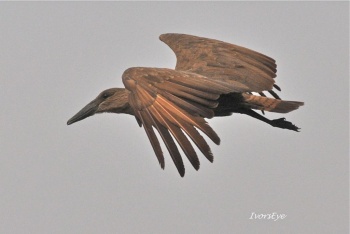- Scopus umbretta
Identification
50–56 cm (19¾-22 in)
Wt. up to 535 g
- Heavy crest
- Flattened black bill
- Heavy, deep and straight
- Black legs and feet
- Brown eye
Distribution
Africa south of the Sahara, Madagascar and south-west Arabia.
Taxonomy
Subspecies
Scopus umbretta has two subspecies:[1]
- S. u. umbretta
- Tropical Africa, Madagascar and south-western Arabia
- S. u. minor
- Coastal western Africa (Sierra Leone to western Cameroon)
Habitat
They are found close to rivers and streams, as well as pans, dams, wetlands or even small rainwater puddles. They are sometimes also seen on the coast, searching rock pools for prey.
Behaviour
This species sometime shows unusual behaviour where a number of birds will suddenly form a tower - sometimes of up to five birds high. Birds perch on the back of the bird below - each calling loudly and excitedly for a while and then seem to simply go off in different directions to continue their hunting. The reason for this strange behaviour is not clear.
Diet
They are usually seen at the water's edge, where they forage for frogs, fish or aquatic invertebrates. They often use a foot to stir up the mud on the bottom to chase out prey. Hamerkops may also hunt by flying slowly over the water and snatching food from the water surface. They live on frogs and tadpoles, fish and aquatic invertebrates. They generally forage singly or in small groups.
Breeding
They nest from July to January. The nest is a massive structure, haystack like, and comprising of sticks, reeds, weeds and debris, placed in the stout fork of a large tree, on a cliff ledge, on large rock or even on the ground. It has an entrance on the underside, and may be built co-operatively, sometimes by several birds. The nest is very solid and durable, and is often taken over by owls, bees or other species.
Vocalisation
Loud, high pitched yelping sound: yip-purrr....yik-yik-yik-yik-purrrr, purr-yik-yik, sometimes in chorus.
References
- Clements, J. F., T. S. Schulenberg, M. J. Iliff, D. Roberson, T. A. Fredericks, B. L. Sullivan, and C. L. Wood. 2016. The eBird/Clements checklist of birds of the world: v2016, with updates to August 2016. Downloaded from http://www.birds.cornell.edu/clementschecklist/download/
- BF Member observations
Recommended Citation
- BirdForum Opus contributors. (2024) Hamerkop. In: BirdForum, the forum for wild birds and birding. Retrieved 26 April 2024 from https://www.birdforum.net/opus/Hamerkop
External Links
GSearch checked for 2020 platform.1






